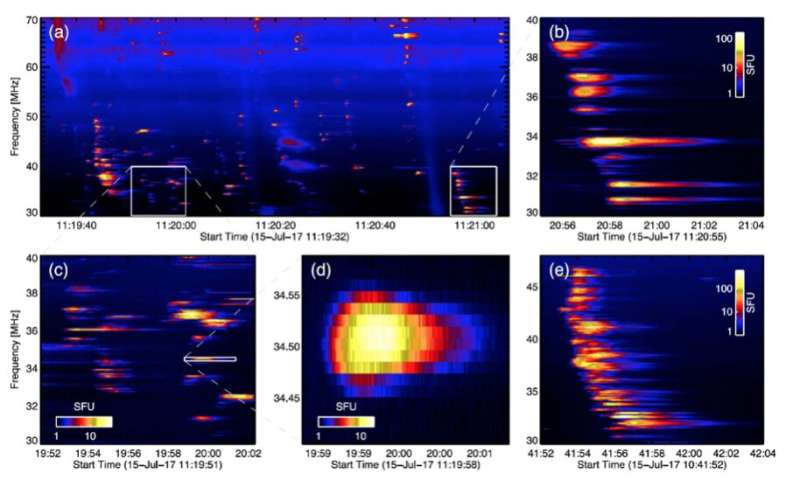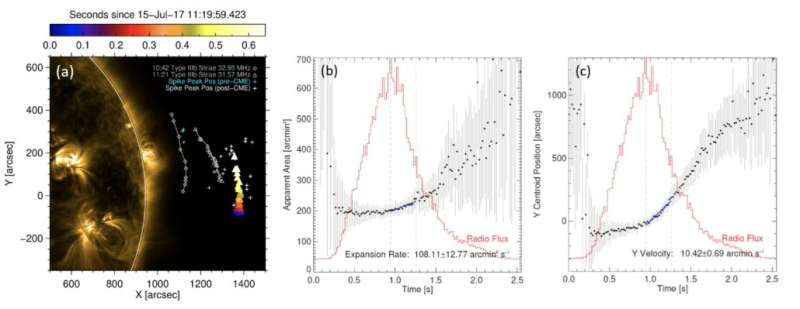Figure 1: (a) Dynamic spectra of spike and Type IIIb bursts. (b) Type IIIb burst (post-CME) (c) Spike cluster (d) An individual spike. (e) Type IIIb burst (pre-CME). Credit: Adapted from Clarkson et al. (2021).
Solar radio spikes are short duration, narrowband radio bursts that are signatures of the acceleration of non-thermal electrons in solar flares. They are observed over a wide range of frequencies from the tens of MHz (Melnik et al. 2014) to the GHz range (Benz et al. 1992) and have some of the shortest durations and narrow bandwidths of any solar radio bursts. The origin of spikes is not fully understood. Their short durations represent an upper limit for the energy release time, and coupled with their narrow frequency bandwidths, spikes are indicative of processes that occur on millisecond timescales, providing an avenue to study the fastest processes in the solar corona. The high brightness temperatures associated with the spikes indicate coherent mechanisms; namely, plasma emission or electron cyclotron maser (ECM) emission.
In the recent paper, Clarkson et al. (2021) have reported for the first time the spatial, frequency, and time resolved observations of individual radio spikes associated with a coronal mass ejection (CME).
Using the time and frequency resolution of LOFAR, we were able to resolve individual radio spikes between 30 and 70 MHz (Figure 1) and analyze their various characteristics, including duration, frequency width, frequency drift, area, and apparent motion over tens of millisecond scales. The flaring event was associated with a series of Type III bursts along with a CME and Type II burst, thought to originate from a jet eruption (Chrysaphi et al. 2020). Spikes were observed both before and after the CME, with the bulk of the observed spikes occurring within the CME wake. The same analysis was performed on individual striae of Type IIIb bursts that occurred during the same period. Both the spikes and striae show similar characteristics—a decreasing duration, increasing bandwidth, and decreasing area, with frequency. We found that the spike drift rates infer exciter velocities of approximately 10–50 km s-1.
Figure 2: Temporal properties of the spike shown in Figure 1d at 34.5 MHz. (a) Spike centroid motion (coloured triangles) overlaid on an SDO/AIA 171 Å image. The blue plus symbols show the peak centroid position of other spikes pre-CME, whilst white plus symbols show those post-CME. The grey lines with diamond (pre-CME) and triangle (post-CME) markers represent the centroid motion of two individual striae from Figure 1(b,e). (b) Observed FWHM area over time. (c) Spike vertical centroid motion over time. The red curves represent the normalised spike lightcurve. Credit: Adapted from Clarkson et al. (2021).
One of the intriguing observations is that the spike (and striae) centroid motions are not radial, but parallel to the solar limb (Figure 2a). Analyzing the temporal variation of the spike area and vertical motion in the image plane (Figure 2b,c), we find that both the change in area extent and motion are most pronounced during the decay phase. The spikes show superluminal velocities between 0.76 and 1.8c and superluminal expansion of the FWHM source sizes. This is not the physical speed of the exciter and can be explained in the context of the scattering of the radio-waves due to anisotropic density turbulence. In Kontar et al. (2019), it was shown that anisotropic density turbulence was required to explain both the observed Type III decay times and source sizes simultaneously. In a medium with anisotropic density fluctuations, radio-wave scattering induces a shift in the observed emission preferentially along the direction of the guiding magnetic field. Further, the scattering simulations predict that apparent superluminal motion is possible due to scattering effects and show that at larger heliocentric angles, the observed emission is subject to greater induced shifts and apparent velocities.
The paper shows that low-frequency radio spikes are strongly affected by scattering due to radiation escaping through anisotropic density turbulence, with scattering preferentially along the guiding magnetic field. For this event, the spike and striae motions indicate that the magnetic field lines are parallel to the solar limb. The spike emission originates in a region within the CME wake where the formation of extended post-reconnection loops could be the location of weak electron beam acceleration. The scattering dominance will act to extend the spike time profile, implying that the energy release time is shorter than what is often assumed in the literature. The simulations by Kuznetsov et al. (2020) show that stronger anisotropy leads to smaller observed peak source sizes and superluminal velocities. The spike and striae properties are therefore consistent with anisotropy α=0.1−0.2, which is higher than typically required in open field configurations to explain Type III bursts. Consequently, the anisotropy of density turbulence in closed loop configurations could be higher than that along open field lines. The similarities and co-spatial origin of the spikes and striae indicate that they have a common exciter. In addition, the Type III, Type IIIb, Type II, and spikes bursts in this event share the same sense of polarization. Combined with the coronal height of the emission where the condition for ECM emission is unlikely to be satisfied, the spikes are likely to be produced via the plasma emission mechanism near the plasma frequency.
More information: Daniel L. Clarkson et al, First Frequency-time-resolved Imaging Spectroscopy Observations of Solar Radio Spikes, The Astrophysical Journal Letters (2021). DOI: 10.3847/2041-8213/ac1a7d
Journal information: Astrophysical Journal Letters
Provided by Community of European Solar Radio Astronomers

























